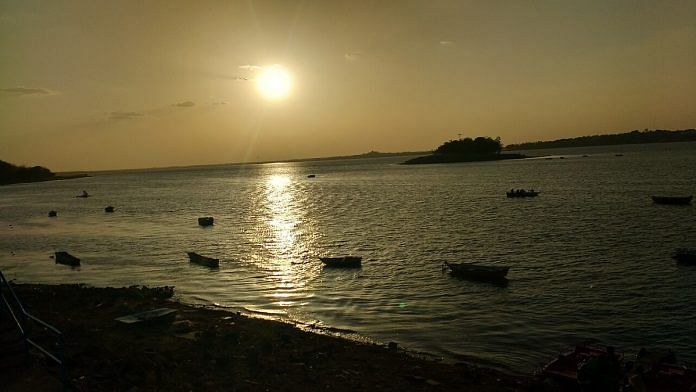


Bhopal: BJP leader and Member of Parliament from Bhopal, Alok Sharma has proposed the exploration of the city’s iconic Upper Lake in search of its ancient history and the remnants of a ‘Vedic city’ that he believes is submerged under the water body, it is learnt.
Sharma made the suggestion Monday during a meeting of Parliament’s departmentally related standing committee on housing and urban affairs in Delhi’s Sansad Bhawan. According to a BJP source, the meeting was organised to evaluate the heritage potential of various cities and to identify projects that could be undertaken for conservation.
Proceedings of parliamentary committee meetings are privileged.
“There are two towers seen protruding from the Upper Lake. It is my understanding that before the lake, there would have been a Vedic city and it should be explored. The towers and the ghat underneath should be searched,” Sharma told ThePrint.
The Upper Lake is believed to have been built during the rule of Raja Bhoj of Parmar dynasty, who ruled from 1010 to 1053 AD. The Vedic age predates his rule and is largely believed to be the period between 1500 BCE and 1000 BCE.
The Upper Lake is part of the Bhoj Wetland, which was designated as a Ramsar site in November 2002.
Sharma added, “As we saw in Sambhal, after digging such a big tunnel was discovered. In the meeting with the archeological and tourism department officers, I proposed they visit Bhopal and study the subject. If you find any evidence, then we will be able to conserve our past for future generations. And if we find something, we can preserve it.”
Last month, local authorities discovered a stepwell believed to be 150 years old along with a tunnel that may have served as an escape route during the 1857 rebellion during an anti-encroachment drive in the Laxman Ganj area of Chandausi in Sambhal.
Also Read: Mahurats, kaals, kasthas to replace hours, mins & seconds — Ujjain’s vedic clock to ring in new time
Sharma emphasised the historic significance of Bhopal, claiming the city had a rich history of over 1,000 years with Samrat Ashoka, Prithviraj Chauhan, Chandragupta Maurya, Raja Bhoj, the Parmar dynasty and Rani Kamlapati ruling for nearly 700 years. For another 300 years, the city was under the rule of Nawabs and Begums, he said.
Raja Bhoj, Sharma claimed, was among the foremost intellectuals of his time, who wrote 84 religious scripts (granths). He was also a poet and an astrologer. “He had done a great deal of work in the field of engineering,” said Sharma.
The demand to explore the historic past of Bhopal city is not new.
In 2016, while inaugurating a bridge over Bhopal’s Lower Lake, then chief minister Shivraj Singh Chouhan announced plans to use advanced technology to explore a ‘Vedic city’ beneath the Upper Lake. Chouhan claimed that Bhopal’s Upper Lake was built by Raja Bhoj. He said Raja Bhoj built the lake by constructing an earthen dam over the Kolans river.
“I believe institutions should be established to study Raja Bhoj who has a great influence on Madhya Pradesh, especially its Malwa region,” said Sharma.
Adding, “The true history of Bhopal needs to come out in the open. Even today there are pillars built during the time of Samrat Ashok, but there has been no effort to preserve it. If today’s government is working and bringing ancient history to light, then I have contributed with my thoughts on the subject.”
Sharma said he would work to collect data on Bhopal’s history and then invite archeology department officials to bring Bhopal’s history to light. “After Raja Bhoj, Rani Kamlapati who was the queen of Bhopal during the 17th century, her history also needs to be brought to the fore. Our next generation should be aware of Bhopal’s history,” Sharma told ThePrint.
“There is no written evidence, but looking at the construction of the bund of the lake, it is similar to the string of lakes constructed near Mandideep, which suggests it might have been constructed during the Parmar dynasty in the 11th century,” Vishakha Kawathekar, a professor at the Department of Conservation at The School of Planning and Architecture Bhopal, told ThePrint.
“But the lake dries up every few years. It would be easier to carry out preliminary search when that happens instead of trying underwater archeology. Besides, in the past, extensive desilting of the lake was carried out, and a lot of mud was removed. All of those reports need to be brought on record,” she added.
“Furthermore, whether there is a Vedic city or not, the Upper Lake has an emotional connection with every citizen of the city. Today, sewage water is discharged into it, encroachments are coming up on its banks. This needs to be stopped. And the lake needs to be conserved.”
Ameeta Singh, professor of history at Bhopal’s Maharani Laxmi Bai Girls PG College, added, “Evidence of early human presence in the region can be found in the striking rock paintings at Manuabhan Tekri, Indira Gandhi Rashtriya Manav Sangrahalaya, and Hamidia Hospital rocks.”
Singh added that archaeological discoveries from the early historical period include a Mauryan pillar found at Bagh Umrao Dulha and ancient coins unearthed near Bargarh, hinting at Bhopal’s role in the Mauryan Empire’s trade and administrative networks.
She also pointed out that the Parmar dynasty left an indelible mark on Bhopal’s cultural landscape. “The city’s name, ‘Bhojpal’, honours Raja Bhoj, a legendary ruler renowned for his expertise in water management and architecture. His most famous creation, the great lake, extended from Bhojpur to what is now the heart of the city.”
Inscriptional evidence reveals Bhopal was a prominent center of learning during the Parmar period, said Singh, adding, “Udayaditya, Raja Bhoj’s heir, mentioned a scholarly institution and a meeting hall, the ‘Sabha Mandap’, located in the Chowk area of the old city.”
(Edited by Sugita Katyal)
Also Read: Andhra Vedic institute’s time has come—IIT to DRDO and ISRO partnerships, govt grants



